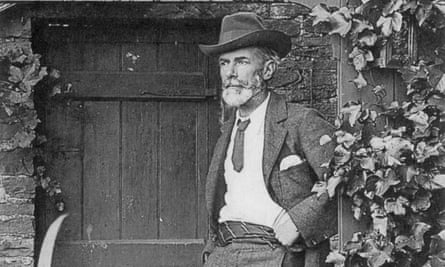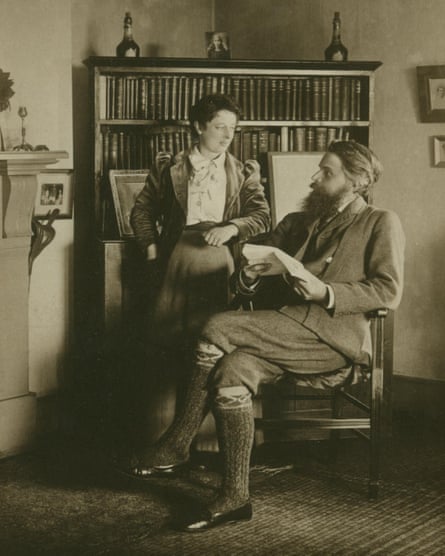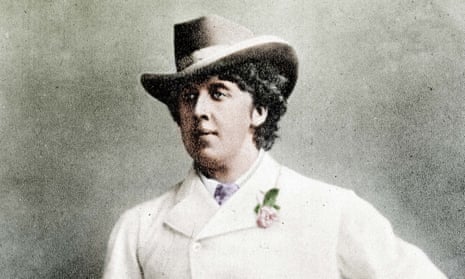Oscar Wilde always imposed. Meeting him in 1892, the French writer Jules Renard reported: “He offers you a cigarette, but selects it himself. He does not walk around a table: he moves the table out of the way … He is enormous, and carries an enormous cane.” The affectations of dress and manner; the extraordinary, magnetic talk; the flourished epigrams; the startling, needling essays, stories and plays – all these were impositions. They were how Wilde forced himself on the attention of the world, made himself notorious, and then famous. And in the ugliness and despair of his downfall – in 1895 he was found guilty of homosexual offences (acts of “gross indecency”) and sentenced to two years of hard labour – he imposed himself again: on the contemporary and historical imagination. But also on the lives of gay men, for 128 years and counting.
There is a well-known passage in EM Forster’s Maurice, written in 1913 but not published until 1971, after Forster’s death. Maurice, who has “failed to kill lust single-handed”, resolves to consult a doctor about his problem. “I am an unspeakable,” he confesses, “of the Oscar Wilde sort.” What is “unspeakable” is immediately revealed by the use of Wilde’s name: that Maurice is homosexual. To be an “Oscar Wilde sort” was to be gay – but was it to be anything like Oscar Wilde? This was the problem troubling men of Forster’s generation and after, at least until the legalisation of homosexuality in England and Wales in 1967 (Scotland did not follow until 1981, Northern Ireland until 1982, Ireland until 1993). Wilde’s scandalous exposure created a set of public assumptions and prejudices that persisted for well over half a century, often twisting how gay people saw themselves. Among these was the belief that gay men, like Wilde, imposed themselves on the world by their difference: that they dressed differently, talked differently, were “theatrical”. That their relationships – as Wilde’s were alleged to have been – were crudely sexual, exploitative, mired in inequalities of age and class. That their susceptibility to blackmail brought them into contact with criminality, made them suspect. That they might always be one misstep away from tragedy. Maurice was an attempt to argue with these ideas, but the fact that Forster felt unable to publish it in his lifetime is a testament to their grip.
The grip has loosened. When the modern gay rights movement marched through the 1960s and 1970s, Wilde was celebrated as its founding martyr, the most notorious victim of homophobia in history. He was already being tentatively reclaimed for literature. Now he became a gay hero, and, ultimately, a pop icon. For new and happier reasons, Wilde imposed himself again. To be gay, still, is to reckon with him as a familiar ancestor: Oscar.
But does Wilde deserve all this? There is no doubt, of course, that he was a victim of homophobia. The Marquess of Queensberry, driven half mad by what he saw as Wilde’s corruption of his son, Lord Alfred Douglas, left a card at Wilde’s club, on which was scrawled (the misspelling has become notorious) “somdomite”. But the trouble only really began when Wilde decided to sue for libel. What both Wilde and his friends knew, of course, was that Queensberry, however distastefully, was telling the truth. Wilde lost his suit against Queensberry, and the police arrested him on the basis of the evidence that had been presented in court. On 25 May he was sentenced. A moral panic ensued. Several months later, when he was being moved between prisons, Wilde was recognised on the platform at Clapham Junction station and spat at by a crowd.

So great was the outpouring of venom, so horrible Wilde’s fate, that it has obscured for well over a century the fact that the early 1890s actually saw the birth of Britain’s first gay rights movement. After Wilde had been sent to prison another gay man, Edward Carpenter, wrote to a sympathetic friend: “There is [a] long campaign to fight.” That word “campaign” is revealing. Wilde was never involved in any campaign for what we would now call gay rights – he specialised in veiled references – but others were. A few years earlier, Carpenter had assisted with collecting the personal testimonies of more than 30 gay men for a book called Sexual Inversion, written by John Addington Symonds and Havelock Ellis (whose collaboration provides the historical inspiration for my novel, The New Life). Sexual Inversion was intended, partly by documenting the life experiences of so-called “inverts”, to demonstrate that homosexuality was not a sin or a degeneracy, but a harmless human quirk, and that the law under which Wilde was later sentenced was unsound, unjust and should be abolished. (It also included the testimonies of six gay women; though there was no law that affected lesbians, social prejudice was strong and the book recognised that women, too, needed to be rescued from stigma.) Carpenter had also written his own defence of homosexuality, titled Homogenic Love and Its Place in a Free Society, intending it to be published in 1894.
The commitments of Carpenter, Symonds and Ellis were rooted in their personal experiences. Carpenter had met the man who would be his partner for life, George Merrill, in 1891; Symonds had emerged from a self-torturing youth to embrace his sexuality in middle age; Ellis, though straight, was married to a lesbian, Edith Lees, and had his own kink (he was aroused by women urinating), which meant that he also knew what it was like to have a stigmatised sexual desire. The inspiration for these men’s pioneering work came partly from Europe. French and German researchers had begun to reconceptualise homosexuality as a medical rather than a social or legal issue. It was already legal to be gay in France and in Italy (where the relevant legislation had been passed in 1889) – making it seem not implausible that the same might be achieved in Britain.
after newsletter promotion

A different kind of inspiration came from the US: Carpenter, Symonds and Ellis were united by a love of Walt Whitman’s poetry (Wilde was also a fan). They understood Whitman to be valorising love between men as a world-improving good, epitomised by the ideal of democratic, cross-class “comradeship”. It’s not surprising that many socialists warmly endorsed Whitman – Carpenter, Symonds and Ellis would all have considered themselves socialists of a sort (again, so would Wilde). It should also not be a surprise – considering the links between the LGBTQ+ movement and feminism today – that if you were a supporter of the homosexual cause, you were also likely to support rights for women. So: the burgeoning gay rights movement in Britain was connected to wider late-Victorian movements for reform, part of a larger impulse to find new and better ways of living in the modern world.
This was the intellectual nexus that was smashed by the Wilde trials. Carpenter’s pamphlet, Homogenic Love, was rejected by his publisher, who also removed Carpenter’s Whitmanesque poem Towards Democracy from his list for good measure. Symonds had died aged only 52 in 1893; Ellis dithered over the publication of Sexual Inversion, and only dared bring it forward in 1897. The first edition was destroyed after Symonds’s literary executor intervened on behalf of his family. Ellis persisted, bringing the book out solely under his own name – only for it to be swept up by the police and prosecuted as obscene. A judge agreed, and the book was destroyed all over again.
And yet it was not the end. Wilde may have become a cultural bogeyman, but subterranean streams of influence extended into the 20th century. Carpenter lived until 1929 and befriended the young Forster – it was a pat on the backside from Carpenter’s partner Merrill that inspired Maurice. “It seemed to go straight through the small of my back,” Forster remembered, “into my ideas.” Carpenter also inspired that rather noisier sexual radical, DH Lawrence. Ellis lived until 1939 and became a world-famous sexologist, a byword for the illicit knowledge that could be gained by curious young people if they took down one of the volumes of his Studies in the Psychology of Sex (published in the US to avoid censorship) from a high shelf in the library. Sexual Inversion took its place as the first of these. Even Symonds had an energetic afterlife. He, too, inspired Forster, who read his sexually frank autobiography in the London Library, where it was locked up until 1984. Symonds’s homosexuality was finally made public in 1964 by a young biographer, Phyllis Grosskurth, whose book was widely reviewed. It was a contribution to the changing mood that finally led to legalisation three years later.
When we celebrate the progress of gay rights, these stories should be given a brighter spot in history, alongside Oscar Wilde. There is not only tragedy and injustice in the past. There is also inspiration and glimpses of a world to come.
